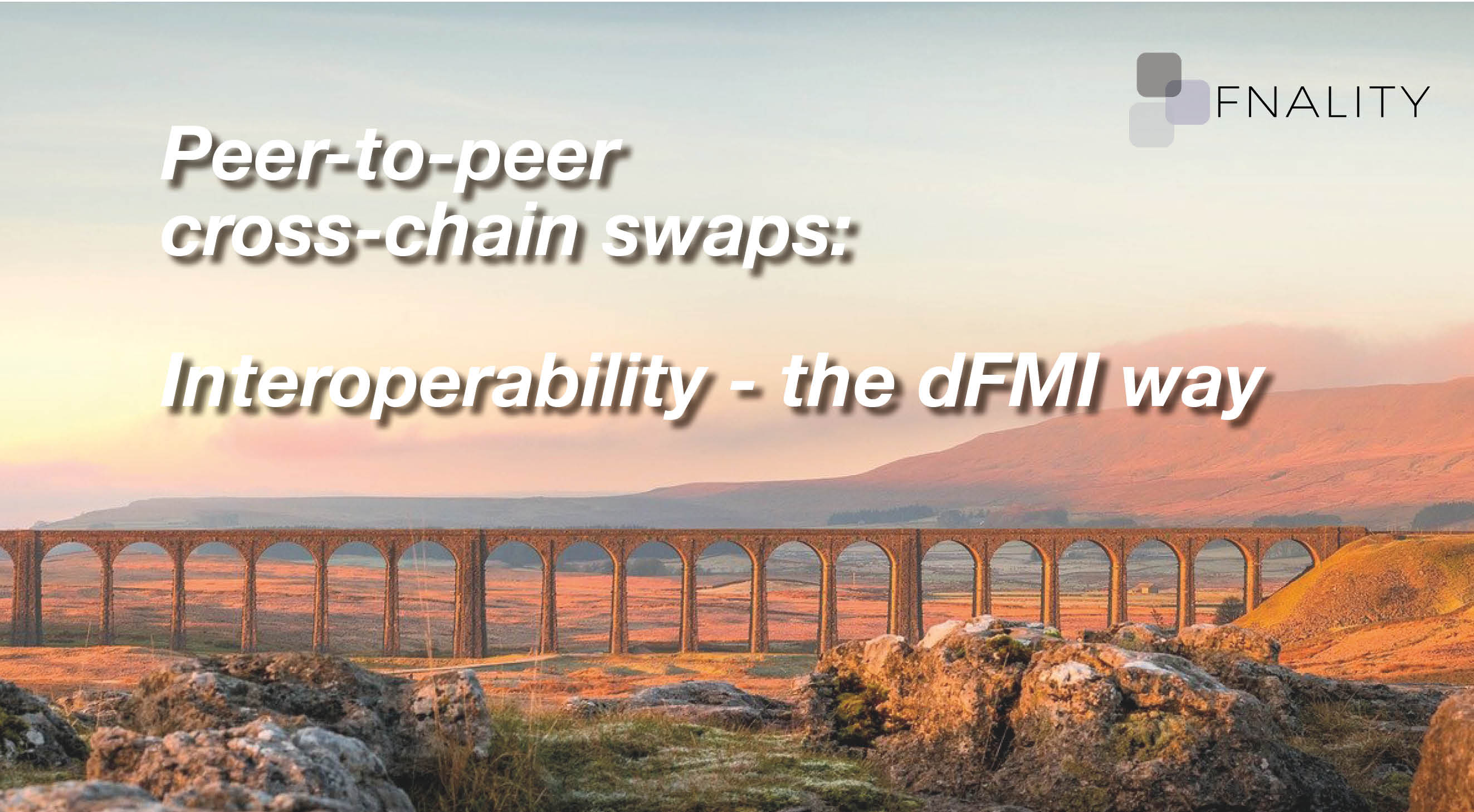
What is interoperability?
In the IT industry, interoperability often refers to the ability of two systems to communicate with each other seamlessly. In the financial context, and leveraging the Committee of Payments and Market Infrastructures (colloquially, the ‘CPMI’) glossary [1], we can see that interoperability is defined as:
- 'the technical or legal compatibility that enables a system or mechanism to be used in conjunction with other systems or mechanisms.’
For example, interoperability across diverse systems is what allows the internet to work; the HTTP(S) protocol allows diverse machines to understand each other irrespective of the operating system they run on, thus enabling the seamless exchange of information we experience every day.
However, in the Blockchain space interoperability often comes with extra nuance, built on top of the previous definition. When the DLT community talks about Bitcoin-Ethereum interoperability, it’s likely that they are instead referring to enabling cross-chain atomic swaps [2]-[3] – i.e. swaps in which either both legs happen or neither of them do. At Fnality, this is precisely our approach to Interoperability; we go beyond the traditional definition to deliver ‘atomicity’, an attribute that is key to delivering value to our consumers in the context of Payment-versus-Payment and Delivery-versus-Payment use cases.
Did you say atomic?
However, what does atomicity really mean? Looking at its etymology, the word comes from Greek (through Latin and Old French): “atomos”, which translates as “indivisible”. This concept can be illustrated at the definitional level by the CPMI’s explanation of [4]-[5] PvP and DvP:
- [PvP] A settlement mechanism that ensures that the final transfer of a payment in one currency occurs if and only if the final transfer of a payment in another currency or currencies takes place.
- [DvP] A securities settlement mechanism that links a securities transfer and a funds transfer in such a way as to ensure that delivery occurs if and only if the corresponding payment occurs.
The key leitmotiv across both definitions is the fact that the final transfer on one side occurs “If and only if” the final transfer on the other side happens too. In this case, we say that these two transfers happen ’atomically’, in other words ‘as one’. Additionally, there can be no uncertainty around it: either both sides happen, or neither does.
Why atomicity matters for Financial Institutions
Why is atomicity important when dealing with cross-chain atomic swaps? To get an idea, we can look to the FX market. In fact, we can draw an immediate parallel between cross-chain swaps and cross-currency (FX) swaps. The argument for having atomicity lies in mitigating settlement risk. Looking back in time, we can trace its inception (or the inception of broad awareness of it) in a relatively small German bank, Herstatt Bank, whose bankruptcy in June 1974 became the symbol for settlement risk (which, in fact, is also known as Herstatt risk). But what exactly is settlement risk? Again, leveraging the CPMI [6], we read:
- [SR] The general term used to designate the risk that settlement in a funds or securities transfer system will not take place as expected. This risk may comprise both credit and liquidity risk.
Unpacking this definition a bit, we can say that settlement risk is the risk that a counterparty to a trade does not pay its dues. In an FX swap, its two legs (the two ’payments’) must be settled successfully for the overall trade to be settled (in other words, they two legs shall be indivisible). If, however, the two legs are settled without atomicity, the counterparties to that trade run the risk that one of the two legs never settles. If this event were to occur, it would leave one counterpart exposed to credit and liquidity risks, as stressed in the CPMI definition.
In fact, Herstatt Bank created this event in the FX markets in 1974 [7]. Back then, Herstatt Bank was heavily active in the Deutsche Mark (DM) / USD FX market. When forced into liquidation by the German Regulators, the Bank stopped all payments. The time difference between Germany and the US implied that the USD supposed to be transferred to the US counterparties of the DM-USD swaps never settled – as they were caught in bankruptcy proceedings. The missed transfer of the US liquidity left the US counterparties short of their expected funds, suddenly scrambling to find liquidity from other sources. Additionally, the US counterparties also incurred credit risk as they had already paid their DM leg of the swap. Hence, this story explains why, even 50 years later, we must guarantee atomicity for cross-chain swaps in the same way we do so in traditional Financial Markets today. Only in this way we will be able to build an ecosystem where settlement risk is properly mitigated. The need for a safer FX settlement process ultimately led to the creation of “Continuous Linked Settlement (CLS) Bank”. This entity can therefore be thought of as the banking industry’s current response to Herstatt risk.
The rationale for peer-to-peer atomic swaps
Here at Fnality, we are building a Payment System based on the principles of ‘decentralised Financial Market Infrastructure’ (dFMI), a Payment System where our Participants’ payments are truly ‘peer-to-peer'. The role of the ‘settlement agent’ is played by consensus, solving the ’double spend’ problem leveraging cryptography. Thus, by being peer-to-peer, the Fnality Payment System (FnPS) can ensure that the exposure of any one Participant is only towards its payment counterparty and no one else, as no intermediary exists. Thus, the peer-to-peer nature of the FnPS decreases counterparty and credit risk, benefitting our participants and the market as a whole [8]. Within each FnPS singularly, this property is guaranteed by the usage of Blockchain, which also provides additional benefits to our participants in terms of lower operational risk and higher resiliency.
However, it is paramount that we can preserve the benefits that dFMI delivers even in the context of cross-chain atomic swaps. In other words, we need to ensure cross chain atomic swaps are truly peer-to-peer and do not reintroduce the need for a settlement agent. On top of that, we also want to make sure that, albeit without intermediaries, atomicity of the cross—chain swaps can still be guaranteed without doubt, to avoid incurring Herstatt-like situations. Finally, this approach must also be sound to ensure compliance with settlement finality regulations. It is a complex problem but only this approach can enable the FnPS to extend the benefits of dFMI beyond simple, single currency payments to PvP and DvP.
At Fnality, we worked with our Partners and our Law Firms, creating an interoperability protocol that takes inspiration from the extensive research and experience developed over the years in the DLT community. In line with Fnality’s culture, we hypothesised, iterated and learnt quickly. At first, we immediately took off the table intermediated approaches [12] as they were deemed incompatible with the dFMI concept. Then, we analysed what the market had to offer in terms of peer-to-peer cross chain swaps [9], especially focusing on understanding the weaknesses and edge cases that could have broken the CPMI definition of PvP and DvP. For example, we looked carefully at the criticalities identified by the Bank of Japan and the European Central Bank in their Joint Stella Reports on PvP [10] and DvP [11] or at the results of projects such as Jasper-Ubin from the Bank of Canada and the Monetary Authority of Singapore [12].
The result of this iterative approach enabled us to craft our own way, with an approach that fully meets the CPMI definition of PvP and DvP without requiring any third party intermediating the settlement process, in line with the dFMI concept. Additionally, we aim to be as open as possible; we firmly believe that the future lies in multiple DLT platforms being able to perform cross-chain atomic swaps at scale, and therefore our solution is technology agnostic and can be implemented across different platforms – much like the HTTP protocol described earlier. Furthermore, our openness is also key to delivering against our vision of a ‘single pool of liquidity for our participants, to satisfy all their business needs’.
What the future holds
At Fnality, we are building a new type of financial infrastructure - dFMI - which removes the need for settlement agents not only for simple payments, but also for PvP and DvP, thanks to our unique interoperability design. In turn, this approach can enable our customers to greatly reduce counterparty and credit risk.
In conclusion, we are excited to be building our first Fnality Payment System. However, we know it is just the beginning of an exciting journey that will lead us to the development and deployment of cross-chain, interoperability-based use cases. At that point, we will be able to meet the DLT promise of ‘decentralization at scale’ and thus truly reimagine the post-trade landscape.
References
[1] CPMI Glossary: interoperability (CPMI, 2016), https://tinyurl.com/y3aezm3z
[2] Ion, the Vision (Clearmatics, 2017), https://tinyurl.com/y6ybpwyc
[3] Ion, Towards a Generalized Interoperability Framework (Clearmatics, 2017), https://tinyurl.com/y69fmvjz
[4] CPMI Glossary: Delivery versus Payment (CPMI, 2016), https://tinyurl.com/y3xqqp7y
[5] CPMI Glossary: Payment versus Payment (CPMI, 2016), https://tinyurl.com/yyrzuat5
[6] CPMI Glossary: Settlement Risk (CPMI, 2016), https://tinyurl.com/y4nc5n9c
[7] BoE Archives reveal little known lesson from the 1974 failure of Herstatt Bank (Bank Underground, 2015), https://tinyurl.com/ybn543a7
[8] distributed Financial Market Infrastructure (dFMI) and the Disintermediation of Digital Assets (Rhomaios Ram, 2018), https://tinyurl.com/y5jq5bmw
[9] Interledger Protocol v1 (ILPv1), Interledger.org, https://tinyurl.com/hmgnlz6
[10] Stella Report: synchronised cross-border payments, (ECB & BoJ, 2019), https://tinyurl.com/yxajrpx7
[11]Stella Report: Securities settlement Systems: delivery versus payment in a distributed ledger environment (ECB & BoJ, 2018), https://tinyurl.com/y3x5vqad
[12] Jasper-Ubin design paper: Enabling cross-border high value transfer using distributed ledger technologies, (BoC & MAS, 2017), https://tinyurl.com/y3blnl54


